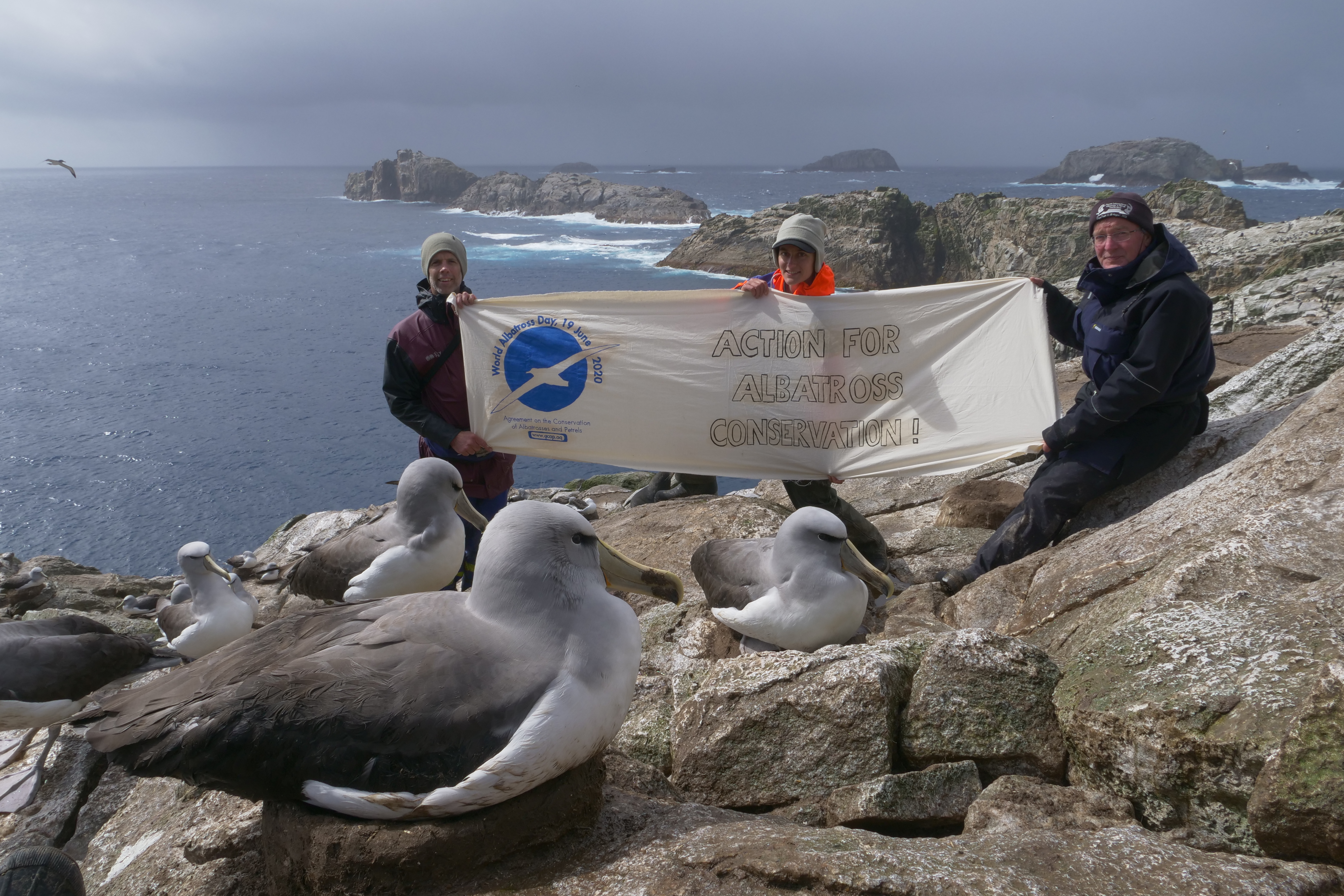As the austral summer commences albatrosses are starting their breeding seasons on islands in the Southern Ocean. In tandem researchers are venturing south and out into the field on these sub-Antarctic islands to continue their monitoring studies of especially Thallasarche mollymauks. At the request of ACAP some have been taking home-made banners with them to advertise next year’s inauguration of World Albatross Day on 19 June.
Following displays of banners on French, South African and UK islands close to breeding albatrosses, New Zealand has now joined the ‘banner challenge’.
Graham Parker and Kalinka Rexer-Huber of the New Zealand-based environmental consultancy Parker Conservation visited the sub-Antarctic Bounty Islands last month – with a banner in their luggage. Along with veteran (now retired) New Zealand albatross researcher, Paul Sagar, they conducted demographic and at-sea tracking research on globally Vulnerable (and Nationally Critical) Salvin's Albatrosses T. salvini on the Bounty Main Group’s Proclamation Island where they displayed their banner. Their research was under subcontract from New Zealand’s National Institute of Water and Atmospheric Research (NIWA).

From left: Graham Parker, Kalinka Rexer-Huber and Paul Sagar display their World Albatross Day banner behind breeding Salvin’s Albatrosses, Proclamation Island, Bounty Islands, 24 October 2019; photograph by Bill Morris
Graham writes to ACAP Latest News of their banner display: “Note that real-estate is at a premium on the islands, so we couldn't get any farther away from albies than we are in the photo. They are a fairly tolerant species though, sharing the space with New Zealand Fur Seals [Arctocephalus forsteri] gives them no choice!”
Graham and Kalinka spent the 2009/10 year on the UK’s Gough Island in the South Atlantic working on the island’s seabirds. Since then they have continued island work together on albatrosses and petrels back home in New Zealand, with Kalinka gaining her PhD on a study of White-chinned Petrels Procellaria aequinoctialis on sub-Antarctic Auckland and Campbell Islands in 2017.
Kalinka has written in support of World Albatross Day: “Albatrosses wander across political borders as readily as they blur sea-sky boundaries, challenging conservation to be truly international and collaborative. World Albatross Day celebrates albatrosses at a fittingly international scale.”
Not to be outdone Graham has also sent in his ‘WAD Quote’ to ACAP: “Albatrosses are emblems of pure wilderness. The greatest contiguous wilderness on earth is the Southern Ocean, and nothing rules that mass of mountainous ocean swells and roaring, furious and screaming winds than albatrosses. Soaring from trough to peak with heart rates the same as when sitting ashore, albatrosses are superbly adapted to our vast southern wilderness.”
Paul Sagar (retired, Marine Ecology Group, NIWA) writes: “Albatrosses nest on some of the most remote islands of the world and travel the High Seas far from land. Yet they still suffer from the effects of a range of human activities that threaten their existence. A World Albatross Day is an excellent way to raise awareness of the plight of these iconic seabirds.”
Parker Conservation’s home-made World Albatross Day banner is going to be well-travelled come the end of the 2019/20 summer. Plans are afoot to take it to Campbell Island this month for monitoring of five albatross species, followed by the Auckland Islands in December/January, and the Snares in March. ACAP Latest News is looking forward to seeing the photographs!
John Cooper, ACAP Information Officer, 18 November 2019

 English
English  Français
Français  Español
Español